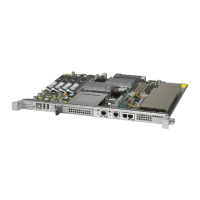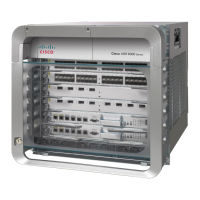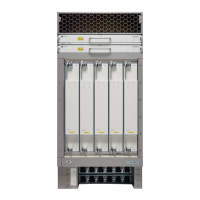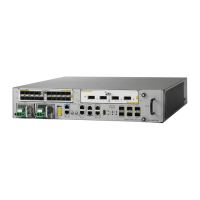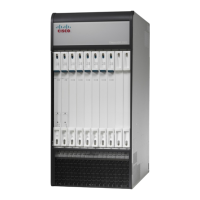11-6
Cisco ASR 1000 Series Aggregation Services Routers Software Configuration Guide
OL-16506-10
Chapter 11 Configuring Bridge Domain Interfaces
Configuring a Bridge Domain Interface
DETAILED STEPS
Example
The following example shows the configuration of a bridge domain interface at IP address 2.2.2.1
255.255.255.0:
Router# configure terminal
Enter configuration commands, one per line. End with CNTL/Z.
Router(config)# interface BDI3
Router(config-if)# ip address 2.2.2.1 255.255.255.0
Router(config-if)# mac-address 1.1.3
Router(config-if)# no shut
Router(config-if)# exit
Router(config)#
You can use different show commands to display the bridge domain interface configuration information:
• show interfaces—Displays the configuration summary of the bridge domain interface.
Example:
Router# show interfaces BDI3
Command or Action Purpose
Step 1
configure terminal
Example:
Router# configure terminal
Enters the global configuration mode.
Step 2
interface BDI{interface number}
Example:
Router(config)# interface BDI3
Specifies the bridge domain interface on a Cisco ASR 1000
Series Router.
Step 3
ip address ip-address mask
or
ipv6 address {X:X:X:X::X link-local |
X:X:X:X::X/prefix [anycast | eui-64] |
autoconfig [default]}
Example:
Router(config-if)# ip address 2.2.2.1
255.255.255.0
Specifies either the IPv4 or IPv6 address for the bridge
domain interface.
Step 4
mac-address {mac-address}
Router(config-if)#mac-address 1.1.3
Specifies the MAC address for the bridge domain interface.
Step 5
no shut
Example:
hostname(config-if)# no shut
Enables the bridge domain interface on the Cisco ASR 1000
Series Router.
Step 6
shut
Example:
hostname(config-if)# shut
Disables the bridge domain interface on the Cisco ASR
1000 Series Router.
